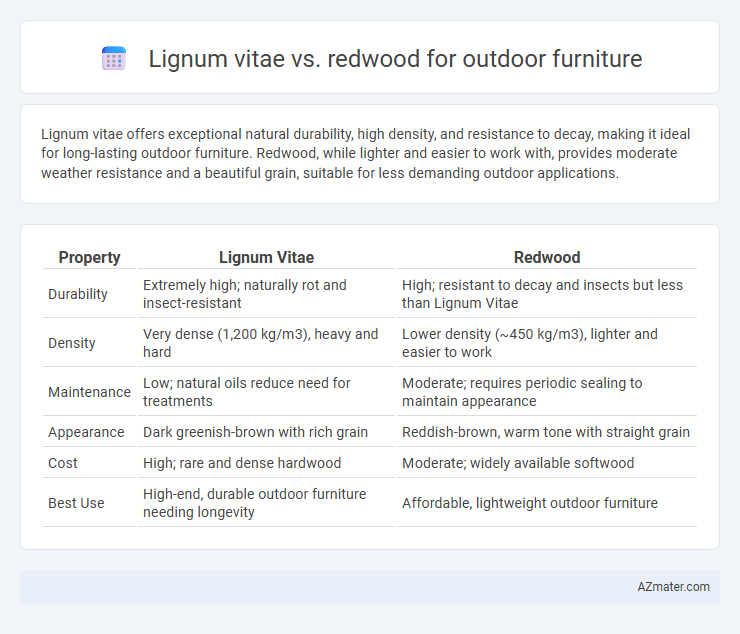Lignum vitae offers exceptional natural durability, high density, and resistance to decay, making it ideal for long-lasting outdoor furniture. Redwood, while lighter and easier to work with, provides moderate weather resistance and a beautiful grain, suitable for less demanding outdoor applications.
Table of Comparison
| Property | Lignum Vitae | Redwood |
|---|---|---|
| Durability | Extremely high; naturally rot and insect-resistant | High; resistant to decay and insects but less than Lignum Vitae |
| Density | Very dense (1,200 kg/m3), heavy and hard | Lower density (~450 kg/m3), lighter and easier to work |
| Maintenance | Low; natural oils reduce need for treatments | Moderate; requires periodic sealing to maintain appearance |
| Appearance | Dark greenish-brown with rich grain | Reddish-brown, warm tone with straight grain |
| Cost | High; rare and dense hardwood | Moderate; widely available softwood |
| Best Use | High-end, durable outdoor furniture needing longevity | Affordable, lightweight outdoor furniture |
Overview: Lignum Vitae vs Redwood
Lignum vitae, renowned for its exceptional density and natural oils, offers superior durability and resistance to rot, making it ideal for long-lasting outdoor furniture. Redwood, prized for its lightweight properties and vibrant reddish hue, provides moderate weather resistance with easier workability but requires periodic maintenance. Both woods withstand outdoor conditions well, yet Lignum vitae's superior hardness and natural preservative qualities make it a premium choice for heavy-use or high-exposure outdoor furnishings.
Key Physical Properties Comparison
Lignum vitae is renowned for its exceptional density, hardness, and natural oils that provide high resistance to rot, decay, and marine borers, making it ideal for durable outdoor furniture. Redwood offers moderate density with natural tannins that resist moisture and insects, yet it is softer and less dense than Lignum vitae, resulting in lower wear resistance over time. Both woods exhibit good weather resistance, but Lignum vitae's superior hardness (Janka rating around 4,500 lbf) and natural oils give it a significant advantage in longevity and maintenance compared to the softer, more porous redwood (Janka rating around 450 lbf).
Durability and Weather Resistance
Lignum vitae is one of the densest and hardest woods, boasting exceptional natural oils that provide superior resistance to rot, insects, and extreme weather, making it ideal for outdoor furniture exposed to harsh environments. Redwood contains natural tannins that resist decay and insect damage but is generally softer and less dense than lignum vitae, offering good durability but requiring more maintenance over time. For long-lasting, weather-resistant outdoor furniture, lignum vitae outperforms redwood by maintaining structural integrity and appearance with minimal upkeep.
Workability and Ease of Crafting
Lignum vitae is dense and oily, offering exceptional durability but requiring specialized tools and more effort for shaping and carving due to its hardness. Redwood is softer and lightweight, making it easier to cut, sand, and assemble with standard woodworking tools, ideal for intricate designs and quick crafting. Both woods resist decay, but redwood's workability provides better ease in crafting detailed outdoor furniture pieces.
Maintenance Requirements
Lignum vitae requires minimal maintenance due to its natural oils that resist moisture, rot, and insect damage, making it highly durable for outdoor furniture. Redwood, while also weather-resistant, demands regular sealing or staining to maintain its appearance and protect against sun damage and moisture absorption. Choosing Lignum vitae reduces the need for frequent upkeep, whereas Redwood needs consistent care to preserve its longevity and aesthetic appeal.
Resistance to Pests and Decay
Lignum vitae offers superior resistance to pests and decay due to its extremely dense heartwood, containing natural oils that repel termites and marine borers, making it ideal for harsh outdoor environments. Redwood, while naturally resistant to decay because of its high tannin content, is less dense and more susceptible to insect damage over time compared to Lignum vitae. Both woods perform well outdoors, but Lignum vitae's unparalleled durability and natural defense mechanisms ensure longer-lasting furniture with minimal maintenance.
Environmental Impact and Sustainability
Lignum vitae, known for its extraordinary density and natural oils, offers superior durability that reduces the need for chemical treatments and frequent replacements, enhancing its environmental sustainability compared to Redwood. Redwood, although renewable and widely cultivated, often requires protective coatings due to lower natural resistance, potentially introducing environmental pollutants. Choosing Lignum vitae supports long-term sustainability through longevity and minimal maintenance, while Redwood's sustainability depends heavily on responsible forestry practices and treatment methods.
Cost Analysis and Availability
Lignum vitae is significantly more expensive than redwood due to its dense, slow-growing nature and limited global supply, making it a premium choice for outdoor furniture that demands durability. Redwood, being more widely available and faster-growing, offers a cost-effective alternative with moderate durability but lower price points due to abundant harvesting in the western United States. The higher initial cost of lignum vitae is offset by its exceptional lifespan and natural resistance to decay, whereas redwood requires more frequent maintenance and replacement, impacting long-term cost considerations.
Visual Appeal and Aesthetics
Lignum vitae features a rich, dark greenish-brown hue with a fine, dense grain that deepens in color over time, offering a luxurious and classic aesthetic for outdoor furniture. Redwood displays warm reddish tones with natural streaks and knots, providing a rustic, vibrant look that enhances outdoor settings with natural charm. Both woods age gracefully, but Lignum vitae's polished finish contrasts with redwood's casual, weathered beauty, enabling distinct visual appeals tailored to design preferences.
Best Applications for Outdoor Furniture
Lignum vitae excels in outdoor furniture applications requiring maximum durability and natural resistance to rot, insects, and marine borers, making it ideal for high-contact pieces like benches and dining tables in coastal or humid environments. Redwood offers a lighter, more affordable option with good weather resistance and natural tannins that inhibit decay, best suited for garden furniture, pergolas, and decorative outdoor seating. Both woods benefit from minimal maintenance but Lignum vitae's exceptional hardness and oily texture provide unmatched longevity in harsh outdoor conditions.

Infographic: Lignum vitae vs Redwood for Outdoor furniture
 azmater.com
azmater.com